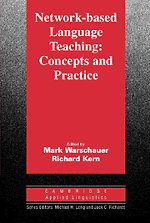 【心得】
【心得】兩位作者回顧了網路語言教學(Network-Based Language Teaching, NBLT)的歷史,說明CALL的教學觀基本上是跟隨語言教學和語言學研究的發展而更革的。傳統上CALL偏重自學、編序應用(programmed application)、操練(drills)、模擬、教學遊戲、測驗等等。但網路作為一種新式CALL的工具,則更強調人際溝通和社會互動。
作者將CALL分為三個主要的流派:結構(Structural)、認知(Cognitive)、社會認知(Sociocognitive),並且說明了各流派主要的觀念和對CALL的看法。
三種流派對於教學的不同詮釋:
| Structural | Cognitive | Sociocognitive | |
| Who are some key scholars? | Leonard Bloomfield, Charles Fries, Robert Lado | Noam Chomsky, Stephen Krashen | Dell Hymes, M.A.K. Halliday |
| How is language viewed? | As autonomous structural system. | As a mentally constructed system. | As a social and cognitive phenomenon. |
| How is language understood to develop? | Through transmission from competent users. Internalization of structures and habits through repetition and corrective feedback. | Through the operation of innate cognitive heuristics on language input. | Through social interaction and assimilation of others speech. |
| What should be fostered in students? | Mastery of a prescriptive norm, imitation of modeled discourse, with minimal errors. | Ongoing development of their interlanguage. Ability to realize their individual communicative purposes. | Attention to form (including genre, register, and style variation) in contexts of real language use. |
| How is instruction oriented? | Toward well-formed language products (spoken or written). Focus on mastery of discrete skills. | Toward cognitive processes involved in the learning and use of language. Focus on development of strategies for communication and learning. | Toward negotiation of meaning through collaborative interaction with others. Creating a discourse community with authentic communicative tasks. |
| What is the primary unit of analysis? | Isolated sentences. | Sentences as well as connected discourse. | Stretches of connected discourse. |
| How are language texts (spoken or written) primarily treated? | As displays of vocabulary and grammar structures to be emulated. | Either as input for unconscious processing or as objects of problem-solving and hypothesis testing. | As communicative acts (doing things with words). |
| Where is meaning located? | In utterances and texts (to be extracted by listener or reader). | In the mind of the learner (through activation of existing knowledge). | In the interaction between interlocutors, writers and readers; constrained by interpretive rules of the relevant discourse community. |
而在實際運用層面,結構派認為CALL主要的功能是可以提供無限的操練、家教般的教學、和正確的回饋。而認知派認為,CALL應該提供語言輸入、分析∕推論的任務,以輔助語言學習。社會認知派則認為,CALL主要功能是提供社會互動,幫助學習者參與言談社群(discourse community)、或者創造新的社群。 因此,結構派的傾向(orientation)是「成品」,而認知派的傾向是「認知過程」,社會認知派的傾向是「認知過程」和「社會交際」。
ps. 雖然這本書主要內容是網路教學,不過本文的範圍是CALL而非NBLT。
=====================
線上全文
- Kern, R., & Warschauer, M. (2000). Introduction: Theory and practice of network-based language teaching. In M. Warschauer & R. Kern (Eds.), Network-Based Language Teaching: Concepts and Practice (pp. 1-19). Cambridge: Cambridge University
沒有留言:
張貼留言